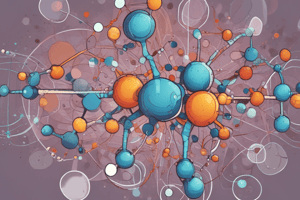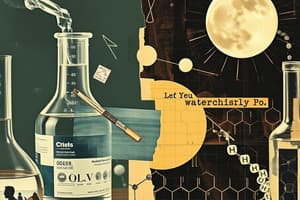Podcast
Questions and Answers
Which of the following scenarios best illustrates a double displacement reaction?
Which of the following scenarios best illustrates a double displacement reaction?
- A metal strip corrodes when exposed to oxygen, forming a layer of metal oxide.
- A single compound breaks down into two simpler substances when heated.
- Two clear solutions are mixed, resulting in the formation of a solid precipitate. (correct)
- A more reactive metal replaces a less reactive metal in a compound.
Consider the reaction: $2H_2O(l) + ext{energy}
ightarrow 2H_2(g) + O_2(g)$. Which statement accurately describes this reaction?
Consider the reaction: $2H_2O(l) + ext{energy} ightarrow 2H_2(g) + O_2(g)$. Which statement accurately describes this reaction?
- The reaction is a neutralization reaction forming a salt and water.
- The reaction is a combustion reaction producing carbon dioxide and water.
- The reaction is exothermic because it releases energy as heat.
- The reaction is endothermic because it requires energy input to proceed. (correct)
In a chemical reaction, a catalyst is used. What effect does the catalyst have on the reaction?
In a chemical reaction, a catalyst is used. What effect does the catalyst have on the reaction?
- It increases the energy required for the reaction to begin.
- It gets consumed during the reaction.
- It lowers the activation energy, thus speeding up the reaction. (correct)
- It shifts the equilibrium towards the reactants.
Which of the following correctly identifies the oxidized and reduced species in the reaction: $Zn(s) + Cu^{2+}(aq)
ightarrow Zn^{2+}(aq) + Cu(s)$?
Which of the following correctly identifies the oxidized and reduced species in the reaction: $Zn(s) + Cu^{2+}(aq) ightarrow Zn^{2+}(aq) + Cu(s)$?
How does increasing the concentration of reactants typically affect the rate of a chemical reaction, and why?
How does increasing the concentration of reactants typically affect the rate of a chemical reaction, and why?
Consider the reversible reaction: $N_2(g) + 3H_2(g)
ightleftharpoons 2NH_3(g)$. At equilibrium, what is true about the rates of the forward and reverse reactions?
Consider the reversible reaction: $N_2(g) + 3H_2(g) ightleftharpoons 2NH_3(g)$. At equilibrium, what is true about the rates of the forward and reverse reactions?
Which type of chemical bond is formed through the sharing of electrons between two non-metal atoms?
Which type of chemical bond is formed through the sharing of electrons between two non-metal atoms?
Which of the following actions would likely increase the rate of a reaction between a solid and a liquid?
Which of the following actions would likely increase the rate of a reaction between a solid and a liquid?
Flashcards
Chemical Reaction
Chemical Reaction
Bonds break, atoms rearrange, and new bonds form.
Combination Reaction
Combination Reaction
Two or more reactants combine to form a single product.
Decomposition Reaction
Decomposition Reaction
One reactant breaks down into two or more products.
Combustion Reaction
Combustion Reaction
Signup and view all the flashcards
Exothermic Reaction
Exothermic Reaction
Signup and view all the flashcards
Endothermic Reaction
Endothermic Reaction
Signup and view all the flashcards
Activation Energy
Activation Energy
Signup and view all the flashcards
Catalyst
Catalyst
Signup and view all the flashcards
Study Notes
- Chemical reactions involve the breaking of existing chemical bonds, the rearrangement of atoms, and the formation of new bonds.
- A chemical reaction involves two or more substances (reactants) interacting to form new substance(s) (products).
Signs of a Chemical Reaction
- Heat is either released (exothermic) or absorbed (endothermic).
- Change in color.
- Production of a gas, often seen as bubbles.
- Formation of a precipitate, which is a solid that separates from the solution.
Types of Chemical Reactions
- Combination reactions occur when two or more reactants combine to form a single product (A + B → AB).
- Decomposition reactions occur when a single compound breaks down into two or more products (AB → A + B).
- Displacement reactions occur when one element replaces another in a compound (A + BC → AC + B).
- Double displacement reactions occur when two compounds exchange parts (AB + CD → AD + CB).
- Combustion reactions occur when a fuel reacts with oxygen to produce carbon dioxide and water (CH₄ + 2O₂ → CO₂ + 2H₂O).
Endothermic vs. Exothermic Reactions
- Exothermic reactions release heat into the surroundings, such as the burning of fuels.
- Endothermic reactions absorb heat from the surroundings, such as photosynthesis or the reaction in an ice pack.
Acid-Base Reactions
- Acids and bases react to form a salt and water (HCl + NaOH → NaCl + H₂O).
- This is also known as a neutralization reaction.
- Acids donate hydrogen ions (H⁺), while bases donate hydroxide ions (OH⁻).
Activation Energy
- Activation energy is the minimum energy required to start a chemical reaction.
- Even exothermic reactions require activation energy to initiate the process.
Catalysts
- Catalysts speed up reactions by lowering the activation energy needed.
- Catalysts are not consumed in the reaction.
- Enzymes in the body are biological catalysts.
Oxidation-Reduction (Redox) Reactions
- Oxidation involves the loss of electrons.
- Reduction involves the gain of electrons.
- In the example Zn + CuSO₄ → ZnSO₄ + Cu, zinc (Zn) is oxidized and copper (Cu²⁺) is reduced.
Concentration
- Higher concentration of reactants generally leads to a faster reaction rate.
- Increasing the concentration increases the number of particles available to react.
Surface Area
- Increasing the surface area of reactants increases the reaction rate.
- More particles are exposed and available for reaction.
Temperature
- Increasing the temperature generally increases the reaction rate.
- Molecules move faster and collide more frequently with greater energy.
Collision Theory
- Particles must collide with sufficient energy and proper orientation to react.
Reversible Reactions
- Reversible reactions can proceed in both forward and reverse directions.
- Equilibrium is reached when the rates of the forward and reverse reactions are equal, resulting in constant concentrations of reactants and products (ex: N₂ + 3H₂ ⇌ 2NH₃).
Metal Reactions
- Metals react with acids to produce a salt and hydrogen gas (ex: Zn + 2HCl → ZnCl₂ + H₂).
Types of Bonding in Reactions
- Ionic bonding involves the transfer of electrons between a metal and a non-metal.
- Covalent bonding involves the sharing of electrons between two non-metals.
Redox Example: Iron Rusting
- Iron reacts with oxygen to form iron oxide (rust): Fe + O₂ → Fe₂O₃
- Iron is oxidized, and oxygen is reduced.
Factors Affecting Reaction Rate
- Increased temperature increases reaction rate.
- Increased concentration increases reaction rate.
- Increased surface area increases reaction rate.
- The presence of a catalyst increases reaction rate.
Studying That Suits You
Use AI to generate personalized quizzes and flashcards to suit your learning preferences.




